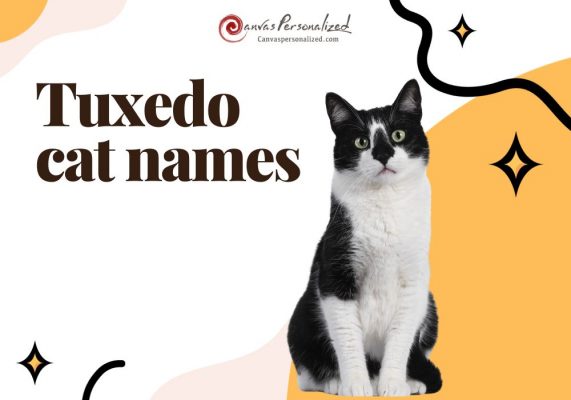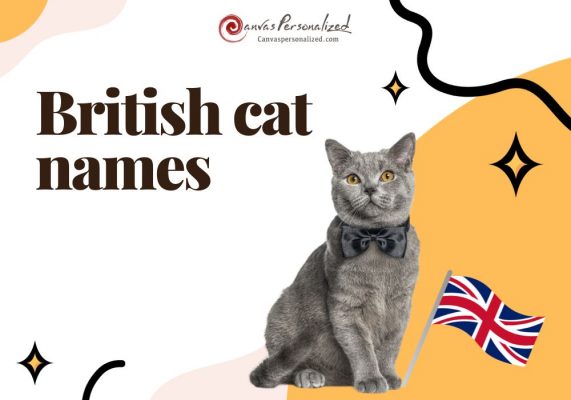Did you know there is a cat whose beauty is very similar to that of a graceful fox? Welcome to the fascinating world of the Somali cat breed, a beautiful but lesser-known kitty that has quietly won the hearts of feline enthusiasts worldwide. With their luxurious coats, elegant bodies, and expressive eyes, Somali cats exude an air of sophistication that is simply irresistible.
In this post, Canvas Personalized will delve into Somali cats’ unique characteristics and delightful personalities, from their intriguing history and distinctive traits to practical tips on caring for them. Let’s begin this adventure together!

1. The History of the Somali Cat Breed
The Somali breed is the long-haired version of the Abyssinian cat. However, their origins are a bit hazy. People think the Somali cat came about when the Abyssinian got the recessive longhair gene from other cat breeds when they started mating.
In Australia in 1965, the first Somali was called the “long-haired Abyssinian” at different cat shows. After this show, breeders saw how attractive the long-haired Abyssinian was, and they started working to make the breed we know today as the Somali. In 1981, the Somali Cat Club was established, and today it has around 150 active members. The Somali cat, a rare and distinctive breed, is now officially recognized by every major cat organization.

2. Somali Cat Characteristics of Appearance
Somali Cat Size
Somalis mature in ways that are consistent with those of more conventional housecats. Kitten teeth fall out, and adult teeth grow in on a Somali cat between the ages of 4 and 6 months. Some of the most spectacular expansions occur throughout this time of six months.
Between the ages of 4 months and 1 year, a Somali kitten will gain roughly 1 pound in weight. They’ll reach adulthood at 18 months old. By the time they’re a year old, they’ll have shed their lanky dimensions and taken on the body type more typical of an adult cat. Adult cats will have a standard weight of 8-12 pounds and live 12 to 15 years.

Coat
These cats have a medium-length coat that is silky and might take up to two years to grow fully. Somali cat breed colors are ruddy, red, fawn, or blue, and their ticking is precise and even, with different shades of light and dark on each hair shaft. The color of the nose leather and paw pads match the color of the coat.

Eyes and Tail
Somali cats have captivating eyes that sparkle with gold or green, the latter being more preferred. Their large, almond-shaped eyes express their emotions vividly, enhanced by the contrast of dark eyelids and light rings around the iris. A sleek, black line accents each eye, extending from the upper lid to the ear lobe.
The base of the Somali cat’s tail is thick and slopes slightly. The tail has a full brush of fur on it. This tail makes it look like a fox.

3. Somali Cat Personality
The Somali breed is a brilliant cat that is good at learning tricks and loves to be the center of attention and show-off. Somali cat behavior can be summed up with the word “very active.” They don’t seem to slow down, no matter how old they get.
Anything that can be light enough to be thrown is a game for a Somali kitten to turn into a toy, from ping pong balls to paper clips to twist ties. They are also good at climbing, exploring, and sneaking around. They have the manual dexterity to open doors and drawers, and some have even figured out how to switch on the water taps so they can make a splash.

This feline is not for people who are easily scared or want a calm lap cat. These guys are always on the move and trying to get everyone’s attention. Somalis are the most like dogs in terms of how they act. They will follow their owners around, bring back their toys, and always be there for them. You can’t do a job without the Somali watching or trying to help.

4. Grooming and Care Tips
Somali cats are blessed with smooth, soft fur that requires brushing once or twice a week to prevent mats and knots. Most Somalis enjoy being groomed, which makes the task easier and more pleasant.
These kittens are prone to periodontal disease, so the owner should brush their teeth regularly at home with vet-approved pet toothpaste and take them to the vet for routine dental check-ups.
Nail care is also important and involves weekly clipping. The owner should inspect the ears weekly for signs of infection, such as redness or bad smell. The ears should be cleaned only when necessary, using a cotton swab moistened with a gentle ear cleaner recommended by the vet.
5. Excercise and Training
Somali cats can maintain a high level of activity thanks to their robust physiques. This is why it’s recommended that you play with them more often than with other types of cats. Play with your Somali several times a day to help it burn off energy and get closer to it. You can also include cat toys in your games to keep their minds active since they have quick thoughts.
Another idea is that leash walks with your Somali cat are possible if you’re adventurous. They are so smart and active, so these cats are simple to train. Occasionally, they will play fetch, and they can be taught basic commands like “sit” and “stay.”

6. Somali Breed Diet and Health Problems
Diet and Nutrition
Every cat is unique, and they all have various food preferences and requirements. Cats, on the other hand, are carnivores and must get 41 different minerals from their food.
About the Somali cat breed, due to their high levels of activity and muscle mass, Somalis require high-quality, protein-rich cat food. You should feed them twice a day with good cat food. Make sure that their diet has more protein-rich meat-based foods than less healthy refined grains and fillers.
Remember that Somalis tend to eat too much when food is easy to get. Make sure you don’t let them eat as much as they want. Talk to your vet to understand what you can and can’t give your cat. They could tell you what kind of food is best for your pet’s age and level of activity.

Common Health Issues
Somali cats often live between 12 and 14 years. With proper care, some cats can even survive to be older than 19 years old. However, like other cat types, they can get some health problems because of how they were raised.
- Pyruvate kinase deficiency: Pyruvate kinase is an important enzyme that red blood cells need, but cats with pyruvate kinase deficiency don’t have it. Symptoms could include tiredness, diarrhea, loss of appetite, drowsiness, weight loss, and a poor-quality coat.
- Progressive retinal atrophy: Over time, the cells in your cat’s retina start to deteriorate. If it isn’t addressed, it can lead to blindness in the long run.
- Amyloidosis: This is a problem with your pet’s kidneys or liver that makes amyloid protein build up in the organs. The blood pressure is too high in these cats. In the worst cases, it can also cause damage to tissue damage and organ failure.
To ensure you get a healthy Somali kitten, you should work with a good breeder who checks your cats’ health regularly.

7. Is the Somali cat suitable for family life?
Somali breed is the perfect companion for families with kids and dogs who love cats. They are playful and smart, enjoying games of fetch and learning new tricks. They know how to avoid babies, but they bond well with older kids who share their adventurous spirit and curiosity. Somalis have been known to get along with large birds, ferrets, and more.
However, the Somalis are likely to find loud, busy homes with lots of guests to be very stressful. This can lead to unwanted behaviors like peeing outside the litter box or harming themselves.

8. The Somali Cat for Adoption and Purchase
These cats are one of the most popular choices for show cats, meaning the purebred Somali breed is usually expensive. So, how much does a Somali cat cost? If you want a reputable breeder, Somali cat prices range from $1,000 to $1,500.
The Somali Breed Council keeps a list of reputable breeders, even though Somalis are uncommon. If a registered cat is not your problem, you may find a Somali mix or a cat that closely resembles a Somali for adoption at a shelter. To make your search easier, we list the 5 most prestigious pet stores in the USA that sell those beautiful felines.
| Pet Shop Name | Contact Information | Location | Description |
|---|---|---|---|
| Kahali Cattery | Phone: (310) 455-8883 Email: kahalicats@abninnovation Website: https://www.kahalicats.com/ | Los Angeles, California | Specializes in Abyssinians and Somalis with 30 years of breeding experience. |
| The Pedigree Paws | Phone: (786) 942-4288 Email: [email protected] Website: https://www.thepedigreepaws.com/kittens-for-sale/somali | Miami, Florida | Offers Somali cats and kittens for sale with a health guarantee and veterinary checks. |
| Petfinder | Website: https://www.petfinder.com/cats-and-kittens/breeds/somali/ | Nationwide | Provides information on Somali cats and kittens available for adoption. |
| Cats R Us | Phone: (718) 792-2287 Email: [email protected] Website: https://www.catsrusnyc.com/ | Bronx, New York | Offers Somali kittens for sale with a health guarantee and veterinary checks. |
| The Cat House on the Kings | Phone: (559) 638-8696 Email: [email protected] Website: https://cathouseonthekings.com/adoptions/cats-for-adoption/ | Parlier, California | Offers Somali cats and kittens for adoption. |
>> Another related post that you may be interested in:
- Oriental Longhair Cat: A Stunning Feline With Captivating Personality
- Chausie Cat Breed: A Wild-Looking Hybrid with a Friendly Personality
In conclusion, the Somali cat breed‘s allure lies in its wonderful companion. Its unusual coat and cheerful disposition make it an instant hit with everybody who welcomes it into their house. Consider adding a Somali kitten to your family for an affectionate and intelligent companion. Share your own cat stories and experiences to let Canvas Personalized know and celebrate the enchanting world of these felines.










